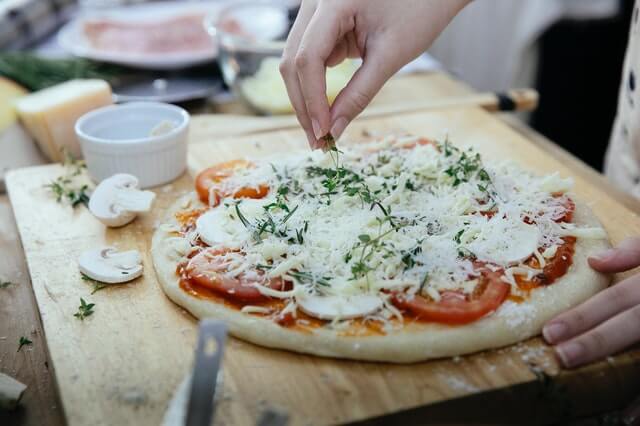
Pizza brings together multiple food groups into one dish, and oh, what a dish it is. It’s also calorie-dense because it is based on dough smothered in tomato sauce and cheese that “glue” the toppings to the crust. Even if you’re watching your diet closely, you can still order the pizza your heart desires. Just read on to learn more about how many carbs and calories are in a slice of pizza.
Carbs and Calories in a Traditional Slice of Pizza

Image used with permission via Pexels by Katerina Holmes
A thin crust pizza gets its name from its crust which is formed from a thin layer of dough and covered with a single layer of toppings. There are variations on the thin crust such as a cracker crust or a fluffy crust, but the concept is the same regardless of how much yeast is used in the dough. The thinner the crust, the fewer calories, but not by much.
You’re more likely to consume fewer calories by going with a tavern-cut thin crust as opposed to a triangle-shaped slice cut. The square tavern-cut slices let you pick up smaller portions, and the thin crust carries fewer carbs. Following is a breakdown of calories, carbs, fat, and protein for a triangle-shaped slice:
A single slice of cheese pizza with dough, tomato sauce, and cheese has:
- 270 calories
- 34g of carbs
- 10g of fat
- 12g of protein
If you top that same slice with pepperoni, you’ll add 28 calories, 2 grams of carbs, and 1 gram of protein.
Pizza dough is the primary source of carbs and calories in a slice of pizza. The type of crust is a factor when you’re tracking what you’re consuming because more dough equals more macros. The next ingredient that adds to the carb content is tomato sauce, but the amount of carbohydrates in tomatoes is much lower than the amount of carbs in the dough.
Make the Most Out of Your Pizza
Pizza isn’t going to help you when you’re watching your macro intake, but that doesn’t mean you should stay away from it entirely. A pizza is intended to be consumed as a meal in itself. When you’re ordering your next pizza, take into consideration the ingredients you want to include. Vegetables make great toppings that pack a lot of flavor and texture without additional carbs. Meat toppings don’t add excessive carbs or calories, either.
Always go with the thinnest crust available because the thinner the crust, the fewer the carbs and calories. If the macros aren’t an issue, go crazy and pick up a deep-dish pizza that’s loaded with delicious ingredients that you won’t regret eating.
Pizza is a perfect food in that it delivers macro and micronutrients in one meal, and it always manages to fill you up and taste delicious. When you’re watching your carb and calorie intake, but you want a pizza, focus on picking ingredients and pizza crust thicknesses that bring the flavor and texture with less of what you don’t want.